英国文学Iwonderedlonelyasacloud赏析整理
- 格式:doc
- 大小:43.00 KB
- 文档页数:6
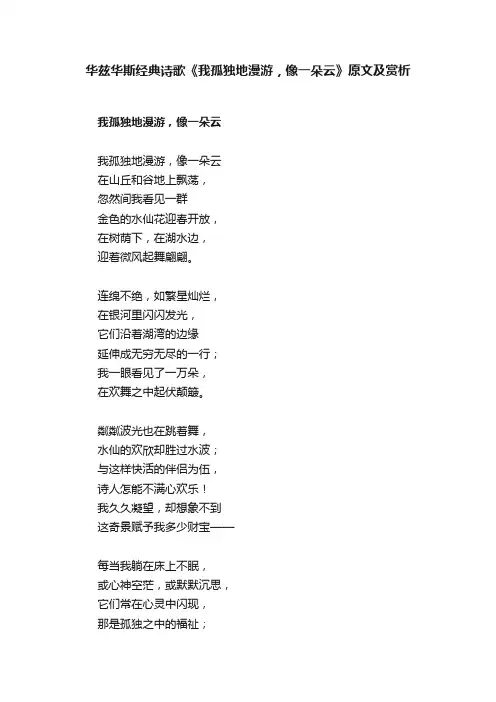
华兹华斯经典诗歌《我孤独地漫游,像一朵云》原文及赏析我孤独地漫游,像一朵云我孤独地漫游,像一朵云在山丘和谷地上飘荡,忽然间我看见一群金色的水仙花迎春开放,在树荫下,在湖水边,迎着微风起舞翩翩。
连绵不绝,如繁星灿烂,在银河里闪闪发光,它们沿着湖湾的边缘延伸成无穷无尽的一行;我一眼看见了一万朵,在欢舞之中起伏颠簸。
粼粼波光也在跳着舞,水仙的欢欣却胜过水波;与这样快活的伴侣为伍,诗人怎能不满心欢乐!我久久凝望,却想象不到这奇景赋予我多少财宝——每当我躺在床上不眠,或心神空茫,或默默沉思,它们常在心灵中闪现,那是孤独之中的福祉;于是我的心便涨满幸福,和水仙一同翩翩起舞。
(飞白译)李好摘要:《我孤独地漫游,像一朵云》是英国浪漫主义诗人华兹华斯的代表作之一,因其文笔清新,自然流畅而广为流传。
本文主要从诗歌的韵律,语篇衔接和思想内容三个方面鉴赏此诗。
威廉·华兹华斯(1770-1850)是“湖畔诗人”的领袖,同时也是19世纪英国浪漫主义诗人的杰出代表。
早年他受到法国启蒙主义思想,尤其是卢梭“回归自然”的影响。
英法战争爆发后,他“归隐”湖畔,致力于诗歌创作,并逐渐构建了自己的诗歌创作理论。
《我孤独地漫游,像一朵云》则是他其中的代表作之一,为英国浪漫主义诗歌的创作定下了基调。
[1]华兹华斯与柯勒律治、骚同被称为“湖畔派”诗人。
他们也是英国文学中最早出现的浪漫主义作家。
他们喜爱大自然,描写宗法制农村生活,厌恶资本主义的城市文明和冷酷的金钱关系,他们远离城市,隐居在昆布兰湖区和格拉斯米尔湖区,由此得名“湖畔派”。
华兹华斯认为“所有的好诗都是强烈情感的自然流露”,主张诗人“选用人们真正用的语言”来写“普通生活里的事件和情境”,而反对以18世纪格雷为代表的“诗歌词藻”。
他进而论述诗和诗人的崇高地位,认为诗非等闲之物,“诗是一切知识的开始和终结,它同人心一样不朽”,而诗人则是“人性的最坚强的保护者,支持者和维护者。

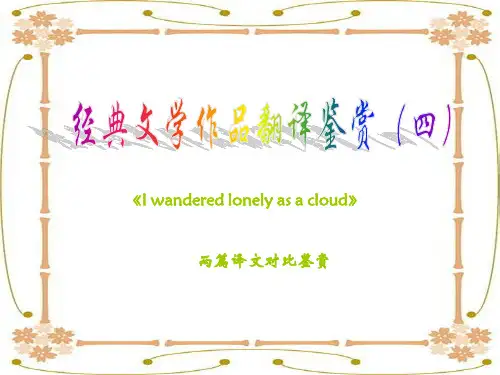
《I wandered lonely as a cloud》两篇译文对比鉴赏关于作者华兹华斯及其贡献华兹华斯,英国诗人,生于律师之家。
1783年他的父亲去世,他和弟兄们由舅父照管,妹妹多萝西则由外祖父母抚养。
多萝西与他最为亲近,终身未嫁,一直与他作伴。
1787年他进剑桥大学圣约翰学院学习,大学毕业后去法国。
他对法国革命怀有热情,认为这场革命表现了人性的完美,将拯救帝制之下处于水深火热中的人民。
1792年华兹华斯回到伦敦,仍对革命充满热情。
但他的舅父对他的政治活动表示不满,不愿再予接济。
于是在1795年10月,他与多萝西一起迁居乡间,实现接近自然并探讨人生意义的宿愿。
William Wordsworth(1770-1850)华兹华斯与Samuel Taylor、Robert Southey同被称为“湖畔派”诗人。
他们是英国文学中最早出现的浪漫主义作家。
他们喜爱大自然,描写宗法制农村生活,厌恶资本主义的城市文明和冷酷的金钱关系,他们远离城市,隐居在昆布兰湖区和格拉斯米尔湖区,由此得名“湖畔派”。
“湖畔派”三诗人中成就最高者为华兹华斯。
他于1789年和柯勒律治合作发表了《抒情歌谣集》,宣告了浪漫主义新诗的诞生。
两年后再版,华兹华斯加了一个长序,在这篇序中,他详细阐述了他的浪漫主义文学主张,主张以平民的语言抒写平民的事物、思想与感情,被誉为浪漫主义诗歌的宣言,动摇了英国古典主义诗学的统治,有力地推动了英国诗歌的革新和浪漫主义运动的发展。
然而纵观他的一生,其诗歌成就是突出的,不愧为继莎士比亚、弥尔顿之后的一代大家。
关于《I wandered lonely as a cloud》这首诗写于诗人从法国回来不久。
诗人带着对自由的向往去了法国,参加一些革命活动。
但法国革命没有带来预期的结果,随之而来的是混乱。
诗人的失望和受的打击是可想而知的,后来在他的朋友和妹妹的帮助下,情绪才得以艰难地恢复。
这首诗就写于诗人的心情平静之后不久。

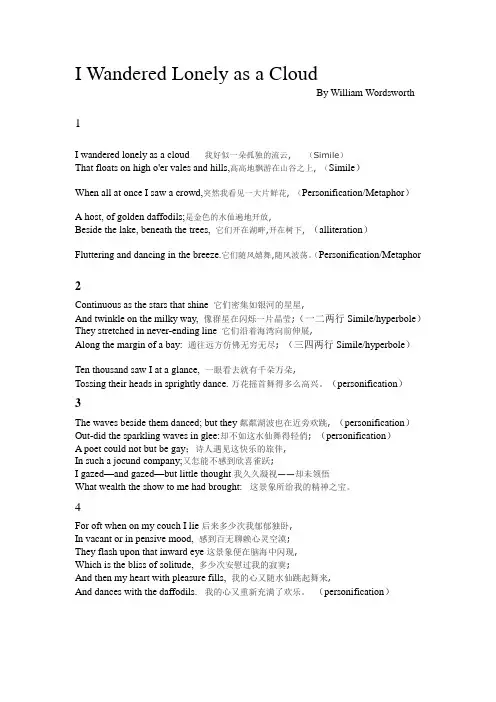
I Wandered Lonely as a CloudBy William Wordsworth1I wandered lonely as a cloud 我好似一朵孤独的流云, (Simile)That floats on high o'er vales and hills,高高地飘游在山谷之上, (Simile)When all at once I saw a crowd,突然我看见一大片鲜花, (Personification/Metaphor)A host, of golden daffodils;是金色的水仙遍地开放,Beside the lake, beneath the trees, 它们开在湖畔,开在树下, (alliteration)Fluttering and dancing in the breeze.它们随风嬉舞,随风波荡。
(Personification/Metaphor2Continuous as the stars that shine 它们密集如银河的星星,And twinkle on the milky way, 像群星在闪烁一片晶莹; (一二两行Simile/hyperbole)They stretched in never-ending line 它们沿着海湾向前伸展,Along the margin of a bay: 通往远方仿佛无穷无尽; (三四两行Simile/hyperbole)Ten thousand saw I at a glance, 一眼看去就有千朵万朵,Tossing their heads in sprightly dance..万花摇首舞得多么高兴。
(personification)3The waves beside them danced; but they粼粼湖波也在近旁欢跳, (personification)Out-did the sparkling waves in glee:却不如这水仙舞得轻俏; (personification)A poet could not but be gay;诗人遇见这快乐的旅伴,In such a jocund company;又怎能不感到欣喜雀跃;I gazed—and gazed—but little thought我久久凝视——却未领悟What wealth the show to me had brought:...这景象所给我的精神之宝。
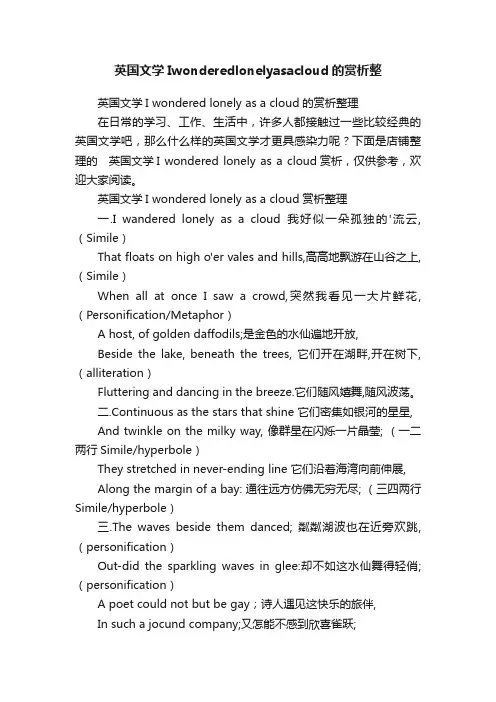
英国文学Iwonderedlonelyasacloud的赏析整英国文学I wondered lonely as a cloud的赏析整理在日常的学习、工作、生活中,许多人都接触过一些比较经典的英国文学吧,那么什么样的英国文学才更具感染力呢?下面是店铺整理的英国文学I wondered lonely as a cloud赏析,仅供参考,欢迎大家阅读。
英国文学I wondered lonely as a cloud赏析整理一.I wandered lonely as a cloud我好似一朵孤独的'流云,(Simile)That floats on high o'er vales and hills,高高地飘游在山谷之上, (Simile)When all at once I saw a crowd,突然我看见一大片鲜花, (Personification/Metaphor)A host, of golden daffodils;是金色的水仙遍地开放,Beside the lake, beneath the trees, 它们开在湖畔,开在树下,(alliteration)Fluttering and dancing in the breeze.它们随风嬉舞,随风波荡。
二.Continuous as the stars that shine 它们密集如银河的星星,And twinkle on the milky way, 像群星在闪烁一片晶莹; (一二两行Simile/hyperbole)They stretched in never-ending line 它们沿着海湾向前伸展,Along the margin of a bay: 通往远方仿佛无穷无尽; (三四两行Simile/hyperbole)三.The waves beside them danced; 粼粼湖波也在近旁欢跳, (personification)Out-did the sparkling waves in glee:却不如这水仙舞得轻俏; (personification)A poet could not but be gay;诗人遇见这快乐的旅伴,In such a jocund company;又怎能不感到欣喜雀跃;I gazed—and gazed—but little thought.我久久凝视——却未领悟What wealth the show to me had brought:...这景象所给我的精神之宝。
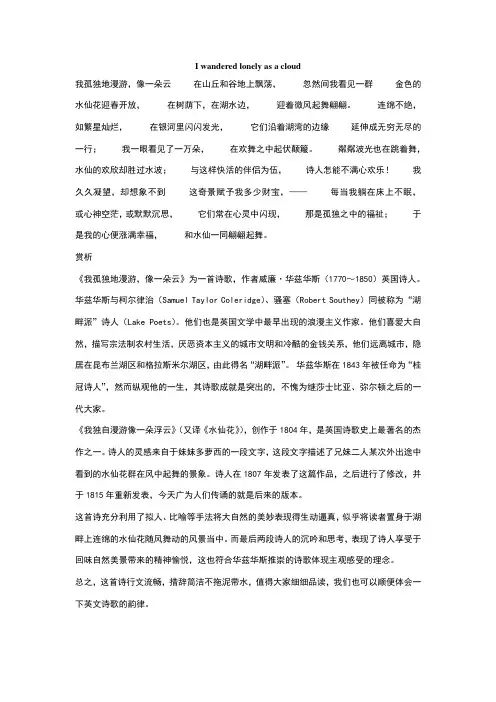
I wandered lonely as a cloud我孤独地漫游,像一朵云在山丘和谷地上飘荡,忽然间我看见一群金色的水仙花迎春开放,在树荫下,在湖水边,迎着微风起舞翩翩。
连绵不绝,如繁星灿烂,在银河里闪闪发光,它们沿着湖湾的边缘延伸成无穷无尽的一行;我一眼看见了一万朵,在欢舞之中起伏颠簸。
粼粼波光也在跳着舞,水仙的欢欣却胜过水波;与这样快活的伴侣为伍,诗人怎能不满心欢乐!我久久凝望,却想象不到这奇景赋予我多少财宝,——每当我躺在床上不眠,或心神空茫,或默默沉思,它们常在心灵中闪现,那是孤独之中的福祉;于是我的心便涨满幸福,和水仙一同翩翩起舞。
赏析《我孤独地漫游,像一朵云》为一首诗歌,作者威廉·华兹华斯(1770~1850)英国诗人。
华兹华斯与柯尔律治(Samuel Taylor Coleridge)、骚塞(Robert Southey)同被称为“湖畔派”诗人(Lake Poets)。
他们也是英国文学中最早出现的浪漫主义作家。
他们喜爱大自然,描写宗法制农村生活,厌恶资本主义的城市文明和冷酷的金钱关系,他们远离城市,隐居在昆布兰湖区和格拉斯米尔湖区,由此得名“湖畔派”。
华兹华斯在1843年被任命为“桂冠诗人”,然而纵观他的一生,其诗歌成就是突出的,不愧为继莎士比亚、弥尔顿之后的一代大家。
《我独自漫游像一朵浮云》(又译《水仙花》),创作于1804年,是英国诗歌史上最著名的杰作之一。
诗人的灵感来自于妹妹多萝西的一段文字,这段文字描述了兄妹二人某次外出途中看到的水仙花群在风中起舞的景象。
诗人在1807年发表了这篇作品,之后进行了修改,并于1815年重新发表,今天广为人们传诵的就是后来的版本。
这首诗充分利用了拟人、比喻等手法将大自然的美妙表现得生动逼真,似乎将读者置身于湖畔上连绵的水仙花随风舞动的风景当中。
而最后两段诗人的沉吟和思考,表现了诗人享受于回味自然美景带来的精神愉悦,这也符合华兹华斯推崇的诗歌体现主观感受的理念。
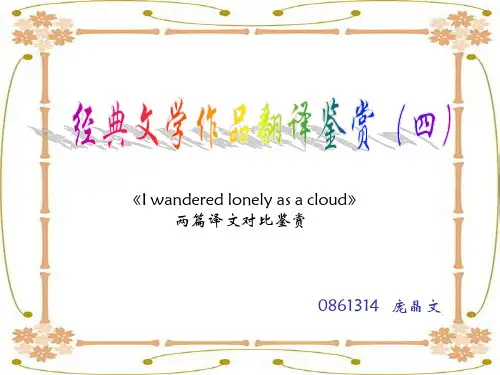

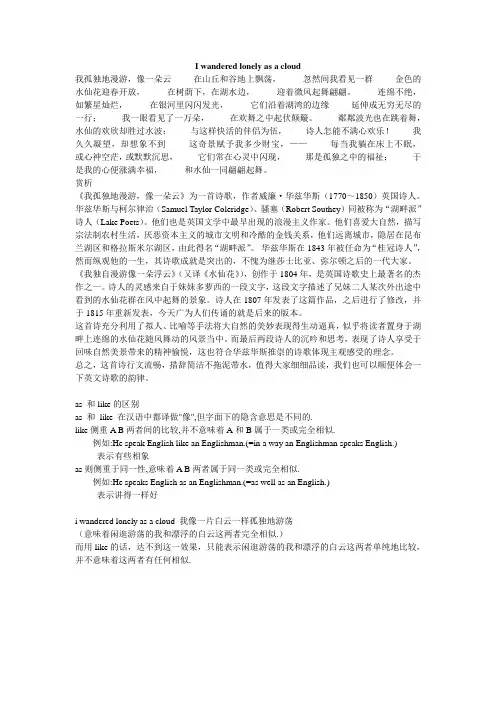
I wandered lonely as a cloud我孤独地漫游,像一朵云在山丘和谷地上飘荡,忽然间我看见一群金色的水仙花迎春开放,在树荫下,在湖水边,迎着微风起舞翩翩。
连绵不绝,如繁星灿烂,在银河里闪闪发光,它们沿着湖湾的边缘延伸成无穷无尽的一行;我一眼看见了一万朵,在欢舞之中起伏颠簸。
粼粼波光也在跳着舞,水仙的欢欣却胜过水波;与这样快活的伴侣为伍,诗人怎能不满心欢乐!我久久凝望,却想象不到这奇景赋予我多少财宝,——每当我躺在床上不眠,或心神空茫,或默默沉思,它们常在心灵中闪现,那是孤独之中的福祉;于是我的心便涨满幸福,和水仙一同翩翩起舞。
赏析《我孤独地漫游,像一朵云》为一首诗歌,作者威廉·华兹华斯(1770~1850)英国诗人。
华兹华斯与柯尔律治(Samuel Taylor Coleridge)、骚塞(Robert Southey)同被称为“湖畔派”诗人(Lake Poets)。
他们也是英国文学中最早出现的浪漫主义作家。
他们喜爱大自然,描写宗法制农村生活,厌恶资本主义的城市文明和冷酷的金钱关系,他们远离城市,隐居在昆布兰湖区和格拉斯米尔湖区,由此得名“湖畔派”。
华兹华斯在1843年被任命为“桂冠诗人”,然而纵观他的一生,其诗歌成就是突出的,不愧为继莎士比亚、弥尔顿之后的一代大家。
《我独自漫游像一朵浮云》(又译《水仙花》),创作于1804年,是英国诗歌史上最著名的杰作之一。
诗人的灵感来自于妹妹多萝西的一段文字,这段文字描述了兄妹二人某次外出途中看到的水仙花群在风中起舞的景象。
诗人在1807年发表了这篇作品,之后进行了修改,并于1815年重新发表,今天广为人们传诵的就是后来的版本。
这首诗充分利用了拟人、比喻等手法将大自然的美妙表现得生动逼真,似乎将读者置身于湖畔上连绵的水仙花随风舞动的风景当中。
而最后两段诗人的沉吟和思考,表现了诗人享受于回味自然美景带来的精神愉悦,这也符合华兹华斯推崇的诗歌体现主观感受的理念。

英诗《咏水仙》艺术特色解读---《名作欣赏·下旬刊》2009年第8期发布: 2010-1-08 10:54 | 作者: 出水莲| 来源: 云梦中文网关键词: 华兹华斯水仙花艺术特色摘要:《咏水仙》是英国诗人威廉·华兹华斯的一首抒情诗。
诗中他以水仙花为主线,描写了大自然的优美风光。
诗人同时借景抒情,流露出了他的悲观情绪。
本文从音韵、视觉、意境三方面来解读诗的艺术特色。
我好似一朵孤独的流云,高高地飘游在山谷之上,突然我看见一大片鲜花,是金色的水仙遍地开放,它们开在湖畔,开在树下,它们随风嬉舞,随风波荡。
它们密集如银河的星星,像群星在闪烁一片晶莹;它们沿着海湾向前伸展,通往远方仿佛无穷无尽;一眼看去就有千朵万朵,万花摇首舞得多么高兴。
粼粼湖波也在近旁欢跳,却不如这水仙舞得轻俏;诗人遇见这快乐的旅伴,又怎能不感到欣喜雀跃;我久久凝视——却未领悟这景象所给我的精神之宝。
后来多少次我郁郁独卧,感到百无聊赖心灵空漠;这景象便在脑海中闪现,多少次安慰过我的寂寞;我的心又随水仙跳起舞来,我的心又重新充满了欢乐。
——[英]威廉·华兹华斯:《咏水仙》①《咏水仙》是英国消极浪漫主义诗人威廉·华兹华斯的代表作之一。
由于华兹华斯在英国西北部的湖畔地区度过了一生中的大半时光,所以又被称作“湖畔派诗人”。
以他为代表的“湖畔派诗人”被认为是英国的第一代浪漫主义诗人。
1843年他被封为桂冠诗人。
同其他“湖畔派诗人”一样,华兹华斯早年同情并歌颂法国革命,后趋向保守,甚至赞扬农村的封建宗法制度,同以拜伦、雪莱为代表的积极浪漫主义形成了鲜明的对比。
华兹华斯认为一切好诗都是强烈情感的自然流露,而思想则改变和指导着情感的流注。
他提倡诗歌的题材应从宫廷转向民间,从城市转向山乡湖畔,主张“选择日常生活的事件和情节”。
因为普通人的生活要比王公贵族的生活含有更多的诗意,田园生活要比宫廷生活、城市生活更富有自然美。
我好似一朵孤独的流云I-wondered-lonely-as-a-cloud评析William Wordsworth’s “I Wandered as Lonely as a Cloud” opens with the narrator describing his action of walking in a state of worldly detachment; his wandering “As lonely as a cloud / That floats on high o'er vales and hills,” (1-2). What he is thinking of we never really uncover, but his description leaves us to analyze his words as a sort of “head in the clouds” daydream-like state where his thoughts are far away, unconcerned with the immediate circumstances in which he finds himself. Wordsworth, ever the Romanticist, perhaps uses these two introductory lines to describe the disconnected and dispassionate ways that we all live our lives; walking through life in a haze of daily ritual and monotonous distractions in a pointless and spiritually disinterested state where we fail as emotional creatures to appreciate the quiet beauties of life that we as human beings need for spiritual sustena nce. William Wordsworth’s “lonely cloud” is our own private impersonal perception of the world, floating miles above it and missing the quiet virtues of nature, beauty, and other sources of emotional nourishment.As William Wordsworth’s narrator is walking, he notices “A host, of golden daffodils;… Fluttering and dancing in the breeze.”(4 and 6). Wordsworth goes on to describe these “golden daffodils” as a vast plot of swaying flowers around the fringes of a bay, outdoing the beauty of the ocean’s waves wi th their own golden oscillation. Describing the daffodils for the next several lines, Wordsworth helps us to vi sualize what he himself has seen and was so moved by; “Tossing their heads in sprightly dance. / The waves beside them danced; but they / Out-did thesparkling waves in glee” (12-14). These light-hearted daffodils, weaving in unison with each other in the wind, have romantically touched Wordsworth, their natural beauty reaching him in ways that he describes as not fully understanding until later: “A poet could not but be gay, / In such a jocund compan y: / I gazed - and gazed - but little thought / What wea lth the show to me had brought:” (15-18).It is here that your humble writer can not help but remember one of William Wordsworth’s earlier poem s that he had written six years earlier. William Wordsworth’s “Lines Written in Early Spring” (1798) serve s the reader in much the same way as Wordsworth’s “I Wandered Lonely as a Cloud”, in that his narrator draws inspiration from nature’s beauty to expe rience a deep and meaningful emotion within himself as a philosopher and a poet. The great difference, however, between Wordsworth’s “Lines Written in Early Spring” and “I Wandered Lonely as a Cloud” is that in “Lines Written in Early Spring” natures beaut y induces in Wordsworth a deep and powerful mourning for how mankind has perverted his own nature in his then modern society, whereas “Lines Written in Early Spring” invigorates Wordsworth’s narrator with the mental imagery of the daffodils.Most importantly, in both poems Wordsworth describes his narrator as having a moment of quiet introspection. In much the same way that most readers can relate, Wordsworth’s narrator in “Lines Written in Early Spring”, upon having a few moments to think to himself, lapses into a depressed state from his own quiet thoughts: “While in a grove I sate reclined, / In that sweet mood when pleasant thoughts / Bring sad thoughts to the mind.” (William Wordsworth’s “Lines Written in Early Spring”, 1798,lines 2-4.). In Wordsworth’s “I Wandered Lonely as a Cloud” his narrator reciprocally, upon relaxing on a couch in quiet con templation, is elated and pleasantly entertained by the thoughts of the daffodils dancing in his memory: “when on my couch I lie / In vacant or in pensive mood, / They flash upon that inward eye / Which is the bliss of solitude; / And then my heart with pl easure fills, / And dances with the daffodils.” (19-24). Wordsworth’s narrator in “I Wandered Lonely as a Cloud” is not grieved by “What man has made of man”(William Wordsworth’s “Lines Written in Early Spring”, 1798, line 8.) but contented and near-tickled by his reminiscence of the golden, light-hearted beauty of the daffodils.A message can be so drawn from this contrast, whether William Wordsworth intended it or not, in a Post-Modern dissection and personal interpretation of a theme that holds as much true to the cannon of Romanticism as to Wordsworth’s own personal philosophy. Perhaps the popular title for Wordsworth’s “I Wandered Lonely as a Cloud”, “Daffodils”, finds, in itself, thevirtue of the poem and its interpretive meaning. The daffodils are, as well as what Wordsworth would have intended, natural beauty; the tranquil occurrences of lucky happenstance that we experience and carry with us in our proverbial hearts as cherished moments and treasured memories. Likely, many readers skimmed Wordsworth’s description of the daffodils and quickly spurned it as a “Romantic blubber” of sorts. Needless to say, however, Wordsworth believes, as does your humble writer, that any human being possessing a soul and beating heart would find themselves deeply touched by the scene of a thousand-foldhost of yellow daffodils swaying in the breeze against the backdrop of waves breaking against the rocks of a bay. This mental image, otherwise missed by those caught up in their daily bustle and contemporary di stractions, their “wandering lonely as clouds” so to speak, is what we draw from nature and experience when we cease our self-destructive pace. If we slow down, just enough, we may catch by the wayside of our wanderings a spiritual creature that could serve us as a pleasant mental image or perhaps even as a meaning or purpose in life.In William Wordsworth’s “I Wandered Lonely as a Cloud”, the daffodils become much more than mere flowers. They are a symbol of natural beauty and, more importantly, symbolize living a life as rich in experience and sensation as would make a life worth living. They represent, in their light-hearted dance, the joy and happiness of living an adoring and fulfilling life, embracing it for every drop of nectar it could so bring. Romanticism, a poetic philosophy that Wordsworth himself engendered, finds much virtue in this meaning; the daffodils reaching out and catching the eye of Wordsworth’s na rrator, or perhaps Wordsworth himself, and inspiring him so much emotionally, that he was left with little choice than to express them poetically. Wordsworth’s narrator of “Lines Written in Early Spring” struggles with his own innate human predisposition towards melancholy in a world where contemporary human society and civilization has destroyed our connection to nature, and incidentally our own nature as well, but Wordsworth’s narrator in “Daffodils” has taken from the moment the sweet nourishment of spiritual manna that was necessary to keep a quiet instance of introspection from turning to depression and, instead, becoming an exuberant reverie of a setting in memory; “They flash uponthat inward eye / Which is the bliss of solit ude; / And then my heart with pleasure fills, / And dances with the daffodils.” (21-24).William Wor dsworth’s “I Wandered Lonely as a Cloud” or “Daffodils” is a deep and moving work of poetry that under a deceivingly simple exterior could possibly be, under energetic dissection, argued as one of Wordsworth’s greatest works of Romanticism. By staying tru e to Romanticism’s philosophy of embracing not only nature but the careful expression of the poet’s emotions through art and how nature can so deeply affect it, Wordsworth, in four simple stanzas if imagery, could, perhaps, not better described in verse the Romantic ideology. The popular title for Wordsworth’s “I Wandered Lonely as a Cloud”, “Daffodils”, has in a single word summed an entire literary philosophy.。
I Wandered Lonely as a CloudBy William Wordsworth1I wandered lonely as a cloud 我好似一朵孤独的流云, (Simile)That floats on high o'er vales and hills,高高地飘游在山谷之上, (Simile)When all at once I saw a crowd,突然我看见一大片鲜花, (Personification/Metaphor)A host, of golden daffodils;是金色的水仙遍地开放,Beside the lake, beneath the trees, 它们开在湖畔,开在树下, (alliteration)Fluttering and dancing in the breeze.它们随风嬉舞,随风波荡。
(Personification/Metaphor2Continuous as the stars that shine 它们密集如银河的星星,And twinkle on the milky way, 像群星在闪烁一片晶莹; (一二两行Simile/hyperbole)They stretched in never-ending line 它们沿着海湾向前伸展,Along the margin of a bay: 通往远方仿佛无穷无尽; (三四两行Simile/hyperbole)Ten thousand saw I at a glance, 一眼看去就有千朵万朵,Tossing their heads in sprightly dance..万花摇首舞得多么高兴。
(personification)3The waves beside them danced; but they粼粼湖波也在近旁欢跳, (personification)Out-did the sparkling waves in glee:却不如这水仙舞得轻俏; (personification)A poet could not but be gay;诗人遇见这快乐的旅伴,In such a jocund company;又怎能不感到欣喜雀跃;I gazed—and gazed—but little thought我久久凝视——却未领悟What wealth the show to me had brought:...这景象所给我的精神之宝。
I Wandered Lonely as a Cloud By William Wordsworth1I wandered lonely as a cloud 我好似一朵孤独的流云, (Simile)That floats on high o'er vales and hills,高高地飘游在山谷之上, (Simile)When all at once I saw a crowd,突然我看见一大片鲜花,(Personification/Metaphor)A host, of golden daffodils;是金色的水仙遍地开放,Beside the lake, beneath the trees, 它们开在湖畔,开在树下, (alliteration)Fluttering and dancing in the breeze.它们随风嬉舞,随风波荡。
(Personification/Metaphor2Continuous as the stars that shine 它们密集如银河的星星,And twinkle on the milky way, 像群星在闪烁一片晶莹; (一二两行Simile/hyperbole)They stretched in never-ending line 它们沿着海湾向前伸展,Along the margin of a bay: 通往远方仿佛无穷无尽; (三四两行Simile/hyperbole)Ten thousand saw I at a glance, 一眼看去就有千朵万朵,Tossing their heads in sprightly dance..万花摇首舞得多么高兴。
(personification)3The waves beside them danced; but they粼粼湖波也在近旁欢跳, (personification)Out-did the sparkling waves in glee:却不如这水仙舞得轻俏; (personification)A poet could not but be gay;诗人遇见这快乐的旅伴,In such a jocund company;又怎能不感到欣喜雀跃;I gazed—and gazed—but little thought我久久凝视——却未领悟What wealth the show to me had brought:...这景象所给我的精神之宝。
4For oft when on my couch I lie后来多少次我郁郁独卧,In vacant or in pensive mood, 感到百无聊赖心灵空漠;They flash upon that inward eye这景象便在脑海中闪现,Which is the bliss of solitude, 多少次安慰过我的寂寞;And then my heart with pleasure fills, 我的心又随水仙跳起舞来,And dances with the daffodils....我的心又重新充满了欢乐。
(personification)1. The poet: William Wordsworth (1770--1850),Poet Laureate“桂冠诗人”,Lake Poets 湖畔派诗人(与Robert Southey一起)2. Background:Poem recaptures a moment on April 15, 1802, whenWordsworth and his sister, Dorothy, were walking near a lake at Grasmere, Cumbria County, England, and came upon a shore lined with daffodils. (据说根据兄妹一起出去玩时看到水仙,被大自然的妩媚所吸引这一经历写成,体现了是人关于诗歌应描写“平静中回忆起来的情感”,emotion recollected in tranquility)3. Theme:1. Nature's beauty uplifts the human spirit. Lines 15, 23, and 24specifically refer to this theme.2. People sometimes fail to appreciate nature's wonders as they go abouttheir daily routines. Lines 17 and 18 suggest this theme.3. Nature thrives unattended. The daffodils proliferate in splendor alongthe shore of the lake without the need for human attention.4. Genre:Lyric poem5. Rhyme Skill:ababcc, efefgg, hihikk, lmlmnn四步抑扬格?6. Structure: four stanzas, each including 6 lines7. Rhetoric(修辞):Simile明喻,personification拟人,hyperbole夸张,alliteration头韵。
(已在文中标出)8. Some Questions(1)What does the image of cloud suggest to you?Loneliness, isolation, solitude, aimlessness, aloofnessI wandered lonely as a cloud---lonelinessThat floats on---aimlessnessHigh over vales and hills---solitude, isolationCloud represents the feelingsof the speaker (the poet) essentially.(2)What has cheered the poet up? And how?a host of golden daffodils,fluttering, dancing and glittering daffodilsShine and twinkle as the starsStretched endlesslyThe cloud-like poet is deeply attracted by the beauty of the nature and turns to be high-spirited, instead of being lonely any more.(3)What has the poet meditated from what he has described? And the theme?In loneliness or in low spirit, the recollection of the nature beauty brings him “the bliss” and “pleasure” in his heart.Therefore the idea of going back to natureis advocated and clearly expressed in this poem.(4)Pay attention to the tense used in this poem. What does it indicate?past tensethe recollection of the past experience will arouse a new sense of the old memories“what wealth the show to me had brought”“the bliss of solitude/ flash upon that inward eye”(5)What does the poem impress you most?Use of imageVivid description of natureDaily language9.诗歌赏析:(仅限参考理解)这首诗基本上是用抑扬格四音步来写的。
每节中第一行和第三行押韵,第二行和第四行押韵,最后两行押韵,这样就产生了一种强烈的节奏感,使此诗顺畅如行云流水,诵之琅琅上口,闻之和谐悦耳,极具音韵美。
此诗的音韵美除了加强音乐性,准确地表现了音响特色外,还充分表达出渗透在艺术形象中的感情色彩,即诗人把优美的形式和深刻的思想结合在了一起,这方面无疑是最重要的。
二、视觉效果《咏水仙》给人一种艺术美的享受。
它的美在于它极其生动形象地摹画了水仙花,在想象中满足了我们的视觉欣赏要求。
这首诗运用不同的修辞手段来转达意象,增强了诗的艺术感染力,使诗的语言更加生动和富有创造力。
在第一节的第一二行里,诗人用明喻把自己比喻成一朵流云飘荡在溪谷群山之上。
这种表达要比一般的描述“我以轻快的步子来回走着”要形象生动得多。
它充分表达了诗人的自由自在、无忧无虑及其悠然自得的神情。
在第一节最后一行和第二节最后一行里,诗人运用了拟人手法:在湖边的树荫下,在微风吹拂中,水仙花千朵万朵起舞波荡,这两行生动地描写了水仙花优美的姿态。
在第三节前两行里又用了拟人手法:“粼粼湖波也在近旁欢跳,却不如这水仙舞得轻俏”,这两行就更加渲染了水仙花的外在美。
美丽的水仙花深深地感染了诗人,使他内心充满欢乐。
在第二节第一二行和第三四行中,诗人用明喻和夸张手法描写了一簇簇水仙花仿若群星璀璨,亮闪闪遍洒银河,沿着海湾向前延伸,通向远方,无穷无尽。
这几行表明了美丽的水仙花开遍大地,显示出它们旺盛的生命力,同时也暗示了诗人对人生价值的渴求以及对美好生活的向往。
诗的最后一行又用了拟人手法,表明了诗人无论什么时候想起它们,心中都会充满快乐。
水仙花成了诗人的精神慰藉,这就更加突出了诗的主题。
上面这些意象交织存在、反复出现,把我们带到了开满水仙花的场面,如身临其境,触景生情,使我们完全被诗人的语言感化了。
如果闭上眼睛想象诗中的语言,我们的脑海里就会勾勒出一幅大自然质朴的美景。
三、意境《咏水仙》的美还体现在它的意境上面。
《咏水仙》带有浓烈的象征主义色彩。
诗中所描写的平静、欢欣的水仙就是诗人自己的象征,在诗中,诗人的心灵和水仙的景象融合了。